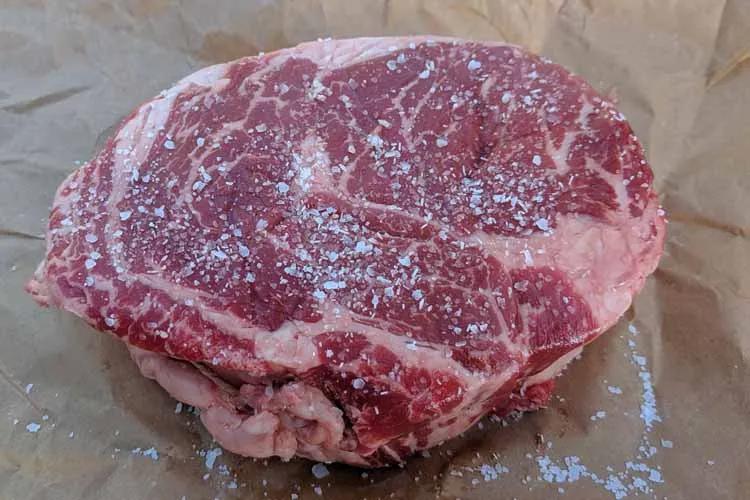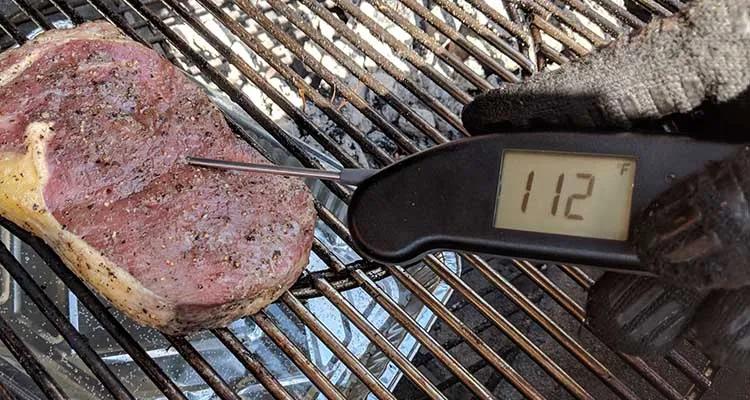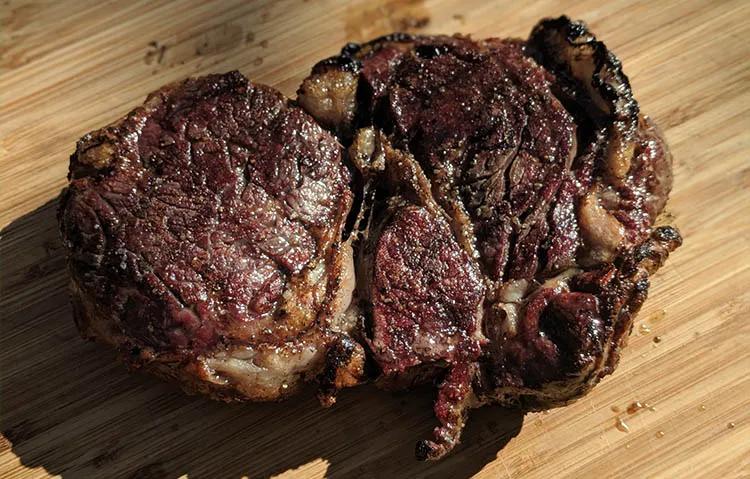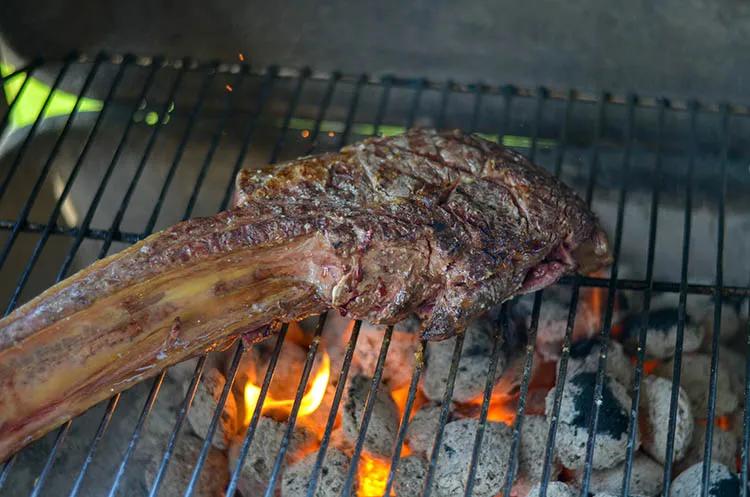Cooking steak is an almost religious experience for some people.
They have a set of rules they follow and they never question them.
Type “how to cook steak” into Google, and you’ll get thousands of articles echoing the same tired old advice. Offering the same “pro-tips” you’ve heard a hundred times from “celebrity” TV chefs.
It turns out a lot of the advice out there is flat out wrong.
It’s time to cut through the noise and put eight of the most common myths about cooking steak to bed.
Myth 1. Don’t salt steak before it’s cooked
This old wives’ tale is usually thrown around without any information on why you shouldn’t be salting your meat before cooking it.
Probably because, under closer examination, salting your steak before you cook it is a fantastic idea.

Salt adds to the flavor of your steak and can reduce surface moisture, giving you better browning. The best time to salt your steak is between 40 minutes to two hours beforehand, depending on its thickness.
Adding salt to the meat, AKA dry brining causes a reaction that, over the first few minutes, will draw the moisture from the meat.
This actually adds to the surface moisture, making it harder to get a good sear if you don’t want long enough.
If left a little longer, the moisture mixes with the salt to become a brine and is absorbed back into the meat. This brine permeates the meat, carrying that all-important seasoning with it.
So when should I salt my steak?
If you’ve got the time, salt your steaks and leave them for one to two hours in the fridge uncovered.
This will give you well-seasoned meat that you can get a good sear on with no reduction in juiciness.
If you don’t have time to do that, salt the meat just before cooking. The worst option is to salt your steak and then leave it for 5 to 10 minutes before cooking.
Myth 2. Steak is best when cooked at room temperature
As with a lot of these pieces of “sage advice,” this one seems sensible on the surface.
Spending 20 minutes bringing your steak up to room temperature supposedly results in a more even cook and a better sear.
The theory is that this is because you won’t be wasting any thermal energy bringing your steak up to temperature. If the steak is already at room temp, all that heat immediately goes into getting you the perfect sear.
The problem is that when J. Kenji López-alt, the Chief Culinary Advisor over at Serious Eats, tested this out, it fell apart pretty quickly.
After 20 minutes of sitting at room temperature, the center of his steak had risen by a whole 1.8°F. After two full hours, he was only 13% closer to the ideal temperature for a medium-rare steak.
But does letting your steak come up to room temperature give you a better sear?
Again, Kenji’s tests say no.
The searing process has very little to do with the starting temperature of your steak. It’s all about evaporating moisture to get that all-important Maillard Reaction.
Evaporating moisture is hard.
“It takes five times more energy to convert a single gram of water into steam than it does to raise the temperature of that water all the way from ice cold to boiling hot.”
J. Kenji Lopez-Alt – Serious Eats
Compared to the thermal energy needed to evaporate the water in your steak, raising its temperature by less than two degrees really doesn’t make that much difference.
So what should you do?
If you are looking to perfect your sear, Kenji suggests removing as much moisture as possible by patting your steak down with paper towels.
If you’ve got the time, you can also try salting them and leaving them uncovered in your fridge. This will remove as much of the surface moisture as possible and increase the efficiency of your sear.
Myth 3. Searing meat locks in the juices
Let’s say this one loud for the people at the back. Searing does not produce a magical impenetrable barrier that locks moisture into your meat.
This particular myth comes from a food chemistry book published in the 1840s and, despite being thoroughly debunked from the 1900s onward, it’s still hanging around.
In fact, the whole idea behind searing or browning meat is to remove moisture from its surface layer and allow the high temperature of your pan or grill to encourage the Maillard Reaction.
This process rearranges the sugars and amino acids in your steak to give you that iconic and intense flavor. If it’s done correctly, it shouldn’t have any effect on how juicy your steak is.
Experiments by food scientists, Cook’s Illustrated and SeriousEats.com have all indicated that meat seared later in the cooking process retains more moisture than beef that is seared immediately.
This is why the reverse sear method is so popular for cooking steak.
What is the point of searing meat?
Sear your meat, but do it for the right reasons.
Forget “locking in the juices.” What you are trying to do is remove surface moisture.
Try patting your steak dry with a paper towel, apply salt two hours before cooking, and get it on a cooking surface that has been heated to between 300°F to 500°F.
Myth 4. Don’t flip your steak more than once
This one seems to come from the same camp as “searing meat locks in the juices” and suggests that cooking one side of your steak thoroughly, before finishing it on the other side, helps to form that magical moisture seal we keep being told about.
The other suggestion is that it somehow contributes to a better sear on your meat. Or that moving your steak more than once causes it to cook unevenly.
The problem is, none of that is even vaguely true.

As food scientist Harold McGee points out, flipping your steak multiple times is a great way to keep it from drying out and actually promotes a more even cook.
By turning your steak repeatedly during the cooking process, one side is prevented from absorbing or losing an excessive amount of heat. This keeps your steak’s internal temperature nice and even.
It can also speed up the rate at which your meat cooks by nearly 30%.
The only possible downside to flipping your steak multiple times is that you might lose out on those steakhouse grill marks.
So how often should I flip my steak?
Feel free to flip your steak over about once every 30 seconds.
You’ll still get all the browning you need, and the constant rotation will result in an evenly cooked steak in less time than the single-flip method.
Sure, you’re not getting to get a perfect cross-hatch grill mark pattern, but the truth is, you want a golden-brown crust on as much of the surface as possible.
While grill marks look enticing, the space between the grill mark is missing out on amazing flavor.
Myth 5. Use the poke test to tell when your steak is done
If you are poking any part of your steak, or yourself, to test if your meat is at the level of doneness you want, stop it!
The idea that you can check temperature changes that might be a small as 5°F by prodding something with your finger is just silly.
So is the idea that we have evolved hands and noses whose texture corresponds directly to the feel of differently cooked steaks.
Your hands and face feel different to pretty much everyone else’s. They also can’t tell what breed of beef you’re cooking, what cut it is, or what cooking surface you are using.
How do I know when my steak is cooked?
The best way to make sure your steak reaches the table exactly how you wanted it, is to invest in an instant read meat thermometer.

As we said in our guide to steak doneness, monitoring temperature is the best way to make sure your steak cooks perfectly.
So get yourself a good instant thermometer, and always remember to take your steaks off the heat 5°F before they hit their ideal temperature.
This will stop you from overshooting as they continue to cook on the way to the table.
Myth 6. You can tell steak doneness by cutting into it
This one tends to come in two flavors:
- “You can tell how well your steak is done by cutting it and looking at the color”
- “Don’t ever cut your steak to tell how well done it is or all the moisture will flow out.”
They are both equally wrong.
As we mentioned, your steak will continue to cook after you take it off the heat.
As it does, its color changes. This makes taking a quick peek at its color a very inaccurate way to measure how cooked it is.
It’s the equivalent of looking at a picture taken randomly during the day and trying to figure out precisely what time it is.
It should also be noted that your steak is not a water balloon. Cutting into your steak will result in a small amount of juice coming out, but not enough that you should ever actively avoid doing it. After all, you’re going to need to cut into it in order to eat it.
So what should I do?
We don’t want to sound like a broken record here, but the best way to check if your steak is done is to use a thermometer.
Many of these alternative methods seem to have evolved in the time-pressured environment of the professional kitchen.
These methods have then been shared by TV chef personalities.
In the serenity of your own home, you can afford to be a little more accurate.
Myth 7. You need to rest your steak after it’s cooked
This is going to be one of the most controversial myths we cover.
Countless TV chefs and recipes stress the importance of resting steak.
The most common reason given for resting your steak is that it makes it juicier.

There are several theories behind why this might happen, such as the meat reabsorbing lost moisture or the juices becoming more viscous as they cool.
The problem is that none of these theories hold water when tested.
Heston Blumenthal, J. Kenji López-alt, Epicurious, and Amazing Ribs’ own Prof. Blonder have all tested the supposed benefits of resting and have been unable to prove it adds anything at all to the juiciness of your steak.
What there is evidence of, is the downside of resting your meat after cooking.
These include your steak getting cold, heat carryover causing your steak to overcook, and the internal moisture softening your steak’s crust.
So what should I do?
Firstly, feel free to ignore this particular myth completely when it comes to steak (or anything you cook quickly).
There are benefits to resting large slow-cooked cuts like brisket.
If you are concerned about your steak’s fluid loss, then Kenji has an alternative method for you:
- Firstly, sear your steak in hot fat
- Then, rest the meat on a wire rack over a rimmed baking sheet
- Before serving, reheat the fat and juices left over until they’re smoking-hot
- Then pour them over the steaks
This method uses any juices lost in the cooking process as a final shot of flavor straight onto the steak.
Myth 8. Steak with the bone-in has a better flavor
This final one is a little different from the rest as it has a grain of truth to it, even if it is subjective.
Some people do enjoy the gristly bits of connective tissue that you can only get from a bone-in steak.

There is absolutely nothing wrong with being what, some less charitable people might refer to as, a “bone-chewer.”
But, by the same token, there are people out there who would recoil in horror at the idea of eating meat off the bone.
The reality is that this steak cooking myth is so generic that it can’t properly apply to anything. There are too many types of bone-in steaks, from too many breeds of animal, cooked too many ways, for this kind of advice to be of any use.
If we were feeling charitable, we might point out that the bone acts as an insulator. This means those bits of meat directly next to it might cook a little less. But, this isn’t going to turn cheap steak into a melt-in-your-mouth treat.
So should I ditch bone-in?
If you enjoy steak with the bone in, go ahead and cook it.
If you don’t like steak with the bone-in, don’t worry. You aren’t missing out on some fantastic flavor sensation.
The breed of animal, the exact cut of steak, and the process you use to cook it will all have a far more significant impact on your meat’s taste than the presence of a bone.
Myths: Busted!
So there we go. Now that we’ve conclusively disproved these myths, we should never see them printed again, right?
Ok, well at least we’ve saved you the time, effort, and potentially sub-par steak, of having to disprove these old steak-wives tales yourself.
Hopefully, you’ve used that time to whip yourself up some truly lovely beef.
If you’re looking for inspiration check out our ultimate guide to steak, the 10 best steaks for grilling, and if you want to treat yourself, we have a round-up of the 10 best butchers that deliver steak.
If you’ve got any steak cooking myths that you think need busting, or that you’ve busted yourself, we’d love to hear about them in the comments below!